.gif)
Interchange (road)
Encyclopedia

Road transport
Road transport or road transportation is transport on roads of passengers or goods. A hybrid of road transport and ship transport is the historic horse-drawn boat.-History:...
, an interchange is a road junction
Junction (traffic)
A junction, when discussed in the context of transport, is a location where traffic can change between different routes, directions, or sometimes modes, of travel.-Historical significance:...
that typically uses grade separation
Grade separation
Grade separation is the method of aligning a junction of two or more transport axes at different heights so that they will not disrupt the traffic flow on other transit routes when they cross each other. The composition of such transport axes does not have to be uniform; it can consist of a...
, and one or more ramps, to permit traffic on at least one highway
Highway
A highway is any public road. In American English, the term is common and almost always designates major roads. In British English, the term designates any road open to the public. Any interconnected set of highways can be variously referred to as a "highway system", a "highway network", or a...
to pass through the junction without directly crossing any other traffic stream. It differs from a standard intersection
Intersection (road)
An intersection is a road junction where two or more roads either meet or cross at grade . An intersection may be 3-way - a T junction or fork, 4-way - a crossroads, or 5-way or more...
, at which roads cross at grade
At-grade intersection
An at-grade intersection is a junction at which two or more transport axes cross at the same level .-Traffic management:With areas of high or fast traffic, an at-grade intersection normally requires a traffic control device such as a stop sign, traffic light or railway signal to manage conflicting...
. Interchanges are almost always used when at least one of the roads is a limited-access divided highway (expressway
Limited-access road
A limited-access road known by various terms worldwide, including limited-access highway, dual-carriageway and expressway, is a highway or arterial road for high-speed traffic which has many or most characteristics of a controlled-access highway , including limited or no access to adjacent...
or freeway), though they may occasionally be used at junctions between two surface streets.
Terminology
Note: The descriptions of road junctions are for countries where vehicleVehicle
A vehicle is a device that is designed or used to transport people or cargo. Most often vehicles are manufactured, such as bicycles, cars, motorcycles, trains, ships, boats, and aircraft....
s drive on the right side of the road. For countries where driving is on the left the layout of the junctions is the same, only left/right is reversed.
- A freeway junction or highway interchange (in the U.S.United StatesThe United States of America is a federal constitutional republic comprising fifty states and a federal district...
) or motorway junction (in the UKUnited KingdomThe United Kingdom of Great Britain and Northern IrelandIn the United Kingdom and Dependencies, other languages have been officially recognised as legitimate autochthonous languages under the European Charter for Regional or Minority Languages...
) is a type of road junction, linking one motorway to another; to other roads; or sometimes to just a motorway service station. On the UK motorway network, most (but not all) junctions with other roads are numbered sequentially. In the U.S., interchanges are either numbered according to cardinal interchange number, or by mileage (typically the latter in most states). - A highway ramp (as in exit ramp and entrance ramp) or slip road is a short section of road which allows vehicles to enter or exit a freeway (motorway).
- A directional ramp always tends toward the desired direction of travel. This means that a ramp that makes a left turn exits from the left side of the roadway (a left exit). Left directional ramps are relatively uncommon as the left lane is usually reserved for high-speed through traffic. Ramps for a right turn are almost always right directional ramps. Where traffic drives on the left, these cases are reversed.
- A non-directional ramp goes in a direction opposite to the desired direction of travel. Many loop ramps (as in a cloverleaf) are non-directional.
- A semi-directional ramp exits a road in a direction opposite from the desired direction of travel, but then turns toward the desired direction of travel. Many flyoverOverpassAn overpass is a bridge, road, railway or similar structure that crosses over another road or railway...
ramps (as in a stack) are semi-directional.
Weaving is an undesirable situation in which traffic veering right and traffic veering left must cross paths within a limited distance, to merge with traffic on the through lane.
The German
Germany
Germany , officially the Federal Republic of Germany , is a federal parliamentary republic in Europe. The country consists of 16 states while the capital and largest city is Berlin. Germany covers an area of 357,021 km2 and has a largely temperate seasonal climate...
Autobahn system splits Autobahn-to-Autobahn interchanges into two types: a four-way interchange, the Autobahnkreuz (AK), where 2 motorways cross, and a three-way interchange, the Autobahndreieck (AD) where two motorways merge.
Complete interchanges
A complete interchange has enough ramps to provide access from any direction of any road in the junction to any direction of any other road in the junction. Complete interchanges typically use four to eight dedicated ramps to connect various directions of travel, but can require more depending on the interchange type and the connectivity offered. For example, if a highway interchanged with a highway containing a collector/express system, additional ramps could be used to strictly link the interchanging highway with the collector and express lanes respectively. For highways with high occupancy vehicle/HOVHOV
HOV may refer to:* High-occupancy vehicle lane* Ørsta-Volda Airport, Hovden in Hovden, Norway* Hovig* A small street gang located in Naperville* see Hov...
lanes, ramps can be used to service these carriageways directly, thereby increasing the number of ramps used.
Cloverleaf interchange

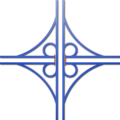
The major advantage of cloverleafs is that they require only one bridge, which makes such junctions inexpensive as long as land is plentiful. A major shortcoming of cloverleafs, however, is weaving (see definition above), and the subsequent low-capacity of this design.
Cloverleafs also require considerable land consumption, hence they appear mostly in the United States, Canada (mainly parclos, or partial cloverleaf interchanges), Germany, and the Netherlands. In Germany, the standard design is to separate all turning traffic into a parallel carriageway so that the extra road space can help minimize the problem of weaving. Collector and distributor roads are similar, but are usually separated from the main carriageway by a divider, such as a guard rail
Guard rail
Guard rail or guardrail, sometimes referred to as guide rail or railing, is a system designed to keep people or vehicles from straying into dangerous or off-limits areas...
or Jersey barrier
Jersey barrier
A Jersey barrier or Jersey wall is a modular concrete barrier employed to separate lanes of traffic. It is designed to both minimize vehicle damage in cases of incidental contact while still preventing crossover in the case of head-on accidents....
.
Cloverleafs are more often found along older highways, in rural areas, and within cities with low population densities.
Stack interchange
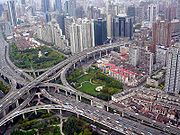
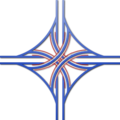
Stacks do not suffer from the problem of weaving but require massive construction work for their flyovers. A standard stack interchange includes roads on four levels. This is not only expensive but also creates an eyesore among local residents, leading to considerable NIMBY
NIMBY
NIMBY or Nimby is an acronym for the phrase "not in my back yard". The term is used pejoratively to describe opposition by residents to a proposal for a new development close to them. Opposing residents themselves are sometimes called Nimbies...
(Not In My Back Yard) opposition. Large stacks with multiple levels are often colloquially described as Mixmasters or spaghetti bowls due to their complex appearance, being compared to boiled spaghetti
Spaghetti
Spaghetti is a long, thin, cylindrical pasta of Italian origin. Spaghetti is made of semolina or flour and water. Italian dried spaghetti is made from durum wheat semolina, but outside of Italy it may be made with other kinds of flour...
.
Cloverstack interchange
In the late 1960s, partial cloverleaf interchange (parclo) designs modified for freeway traffic emerged, eventually leading to the cloverstack interchange. Its ramps are longer to allow for higher ramp speeds, and loop ramp radii are made larger as well. The large loop ramps eliminate the need for a fourth, and sometimes a third level in a typical stack interchange, as only two directions of travel use flyover/under ramps.Cloverstacks are cheaper to build than stack interchanges and are less of an eyesore for local residents. By using the loop ramps in opposite quadrants, weaving is also eliminated. However, cloverstacks require a lot of land to construct and the loop ramps are not as efficient as flyover/under ramps in terms of traffic flow. The cloverstack design is becoming more and more popular, and is commonly used to upgrade cloverleaf interchanges to increase their capacity and eliminate weaving.
Turbine interchange

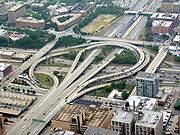
Spiral
In mathematics, a spiral is a curve which emanates from a central point, getting progressively farther away as it revolves around the point.-Spiral or helix:...
pattern in right-hand driving.
Turbine interchanges offer slightly less vehicle capacity because the ramps typically turn more often and change height quicker. They also require more land to construct than the typical four-level stack interchange.
In areas with rolling or mountainous terrain, turbine interchanges can take advantage of the natural topography of the land due to the constant change in the height of their ramps, and hence these are commonly used in these areas where conditions apply, reducing construction costs compared to turbine interchanges built on level ground.
Roundabout interchange
A further alternative found often in the United KingdomUnited Kingdom
The United Kingdom of Great Britain and Northern IrelandIn the United Kingdom and Dependencies, other languages have been officially recognised as legitimate autochthonous languages under the European Charter for Regional or Minority Languages...
is called a roundabout interchange. This is a normal roundabout except one (two-level) or both (three-level) mainlines pass under or over the whole thing. The ramps of the interchanging highways meet at a roundabout
Roundabout
A roundabout is the name for a road junction in which traffic moves in one direction around a central island. The word dates from the early 20th century. Roundabouts are common in many countries around the world...
or rotary on a separated level above, below, or in the middle of the two highways.
Roundabout interchanges are much more economical in use of materials and land than other interchange designs, as the junction does not normally require more than three bridges to be constructed. However, their capacity is limited when compared to other interchanges and can become congested easily with high traffic volumes.
A variation of this interchange has been proposed by a Ukrainian engineer Viktor Petruk. The claimed advantages of this type of interchange are: low number of conflict points, short car paths on the circle, and relatively small overall size that allows it to be used in dense urban environment. Unfamiliarity of clockwise traffic flows on roundabouts is its most frequently cited drawback.
Other/hybrid interchanges

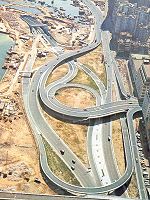
A windmill interchange
Windmill interchange
The windmill interchange is a four-way road interchange.The windmill serves two arterial roadways by grade separation. All turning movements are served by a right-hand exit ramp, with stop sign or traffic signal at the ramp termini....
is similar to a turbine interchange, but it has much sharper turns, reducing its size and capacity. A variation of the windmill, called the diverging windmill, increases capacity by altering the direction of traffic flow of the interchanging highways, making the connecting ramps much more direct. The interchange is named for its similar overhead appearance to the blades of a windmill
Windmill
A windmill is a machine which converts the energy of wind into rotational energy by means of vanes called sails or blades. Originally windmills were developed for milling grain for food production. In the course of history the windmill was adapted to many other industrial uses. An important...
.
Divided volleyball interchanges create a wide median between the carriageways of the two interchanging highways, using this space for connecting ramps.
Full diamond interchanges are large, multi-level interchanges that use flyover/under ramps to handle both right and left ramps.
Trumpet interchange

These interchanges are useful for highways as well as toll roads, as they concentrate all entering and exiting traffic into a single stretch of roadway, where toll booths can be installed. A double-trumpet interchange version can be found where a toll road meets another toll road or a free highway.
Trumpet interchanges are named as such due to their resemblance to trumpet
Trumpet
The trumpet is the musical instrument with the highest register in the brass family. Trumpets are among the oldest musical instruments, dating back to at least 1500 BCE. They are played by blowing air through closed lips, producing a "buzzing" sound which starts a standing wave vibration in the air...
s. The bell of a trumpet can be seen where the terminating highway begins to interchange with the continuous highway, and the resemblance to the tubing is seen along the connecting loop ramps.
Directional T interchange
A directional T interchange uses flyover/under ramps in all directions at a three-way interchange. A semi-directional T does the same, but some of the splits and merges are switched to avoid ramps to and from the passing lanePassing lane
A passing lane or overtaking lane is the lane on a multi-lane highway or motorway closest to the center of the road ....
. Directional T interchanges are very efficient, but are expensive to build compared to other three-way interchanges. They also require three levels, which can be an eyesore for local residents. However, the T-interchange is perferred to a trumpet interchange because a trumpet requires a loop ramp which speeds can be reduced to as much as 25 MPH (US), but flyover ramps can handle much faster speeds.
Full Y interchange
A full Y-interchange is typically used when a three-way interchange is required for two or three highways interchanging in semi-parallel/perpendicular directions, but it can also be used in right-angle case as well. Their connecting ramps can spur from either the right or left side of the highway, depending on the direction of travel and the angle.Full Y-interchanges use flyover/flyunder ramps for both connecting and mainline segments, and they require a moderate amount of land and moderate costs since only two levels or roadway are typically used. They get their name due to their resemblance to the capital letter "Y", depending upon the angle from which the interchange is seen. Two examples of this type of interchange can be found in the Province of Ontario: the Highway 403
Highway 403 (Ontario)
King's Highway 403, also known as Highway 403, is a 400-series highway in the Canadian province of Ontario that travels between Woodstock and Mississauga, branching off from and reuniting with Highway 401 at both ends and travelling south of it through Hamilton and Mississauga. It is concurrent...
/Highway 6
Highway 6 (Ontario)
King's Highway 6, also known as Highway 6, is a provincially maintained highway in the Canadian province of Ontario. It crosses a distance of between Port Dover on the north shore of Lake Erie and Espanola on the northern shore of Lake Huron, ending at the Trans-Canada Highway in McKerrow.- Port...
interchange in Hamilton, and the Highway 417
Highway 417 (Ontario)
King's Highway 417, also known as Highway 417 and the Queensway through Ottawa is a 400-series highways in the Canadian province of Ontario which connects Montreal with Ottawa. It is the backbone of the transportation system in the Ottawa region, where it forms part of the Queensway along with...
/Highway 416
Highway 416 (Ontario)
King's Highway 416, commonly referred to as Highway 416 and as the Veterans Memorial Highway, is a 400-series highway in the Canadian province of Ontario which connects Highway 417 in Ottawa with Highway 401 between Brockville and Cornwall...
interchange in Ottawa
Ottawa
Ottawa is the capital of Canada, the second largest city in the Province of Ontario, and the fourth largest city in the country. The city is located on the south bank of the Ottawa River in the eastern portion of Southern Ontario...
.
Other/hybrid interchanges
Hybrid interchanges use a mixture of interchange types and are not uncommon. Their construction can consist of multiple interchange designs such as loop ramps and flyovers. One place to find hybrids are near Santa Clarita, CaliforniaSanta Clarita, California
Santa Clarita is the fourth largest city in Los Angeles County, California, United States and the twenty-fourth largest city in the state of California. The 2010 US Census reported the city's population grew 16.7% from the year 2000 to 176,320 residents. It is located about northwest of downtown...
, all along Interstate 5
Interstate 5
Interstate 5 is the main Interstate Highway on the West Coast of the United States, running largely parallel to the Pacific Ocean coastline from Canada to Mexico . It serves some of the largest cities on the U.S...
and California State Route 14
California State Route 14
State Route 14 is a north–south state highway in the U.S. state of California, largely in the Mojave Desert. The southern portion of the highway is signed as the Antelope Valley Freeway. The route connects Interstate 5, or Golden State Freeway, near Santa Clarita and with U.S. Route 395 near...
.
A half-clover interchange is essentially half a cloverleaf interchange, constructed to connect in just three directions instead of four. These are rarely used due to the traffic weaving that they cause and the large amount of land that they consume, but they can be built in areas where the connecting ramp along the loop of a trumpet interchange is not feasible due to building developments or physical limitations. Half-clovers are designed to be readily upgraded to full cloverleafs if the terminating highway is ever extended past the through highway. A notable example of a half-clover interchange is with M-47
M-47 (Michigan highway)
M-47 is a north–south state trunkline highway in the US state of Michigan. It runs near Saginaw and Midland in the Tri-Cities area of the Lower Peninsula. The highway runs through suburban and agricultural areas to connect the two cities with the airport in the area. The northernmost section of...
and U.S. Route 10
U.S. Route 10
U.S. Route 10 is an east–west United States highway formed in 1926. Though it never became the cross-country highway suggested by the "0" as the last digit of its route number, U.S...
near Midland, Michigan
Midland, Michigan
Midland is a city in the U.S. state of Michigan in the Tri-Cities region of the state. It is the county seat of Midland County. The city's population was 41,863 as of the 2010 census. It is the principal city of the Midland Micropolitan Statistical Area....
, since M-47 was the relic of a scrapped plan to extend a freeway further north. Interstate 75
Interstate 75
Interstate 75 is a major north–south Interstate Highway in the Great Lakes and Southeastern regions of the United States. It travels from State Road 826 and State Road 924 in Hialeah, Florida to Sault Ste. Marie, Michigan, at the Ontario, Canada, border...
to its east near Bay City, Michigan
Bay City, Michigan
Bay City is a city in the U.S. state of Michigan located near the base of the Saginaw Bay on Lake Huron. As of the 2010 census, the city's population was 34,932, and is the principal city of the Bay City Metropolitan Statistical Area, which is included in the Saginaw-Bay City-Saginaw Township North...
, a more important destination, made this highway unnecessary.
A 3/4 volleyball interchange is a divided-volleyball interchange designed to meet at three points instead of four. Like the half-clover, it can easily be upgraded to a fully divided volleyball interchange if the terminating highway is extended beyond the through highway.
A T-bone interchange is essentially a compacted directional T interchange with sharper turns and a lower capacity, built when there is insufficient land or funds to build a directional T. Its two flyover/flyunder ramps contract together after passing over the through highway, but then they split into two segments, resembling the bone in a T-bone steak.
Two-way interchanges
A half trumpet interchange is essentially a trumpet interchange without its loop ramp and one of its directional ramps designed to meet the continuous highway in one direction, usually on a ninety degree or semi-perpendicular angle. Should the need arise, it can easily be constructed into a trumpet interchange, making it a three-way interchange.A partial y interchange is used where one highway terminates at another highway with the same general directional alignment (usually a maximum of sixty degrees). The trunk of the terminating highway merges with the trunk of the continuous highway; vehicles traveling into the interchange may only exit traveling in the same direction. This type of interchange is often used for bypass routes
Bypass (road)
A bypass is a road or highway that avoids or "bypasses" a built-up area, town, or village, to let through traffic flow without interference from local traffic, to reduce congestion in the built-up area, and to improve road safety....
, and is named for the shape the two highways' confluence makes when drawn on a map, creating a lower-case "y".
Hybrids, variations, and rare types also exist for two-way interchanges.
One-way interchanges
A Dual highway setup is used when one highway (usually parallel) joins up with another highway, creating two highways in one direction. These two highways can further join together and form one highway.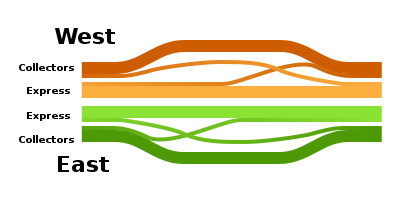
Diamond interchange
A diamond interchange is an interchange involving four ramps where they enter and leave the freeway at a small angle and meet the non-freeway at almost right angles. These ramps at the non-freeway can be controlled through stop signs, traffic signals, or turn ramps. Diamond interchanges are inexpensive to build and require little land but are prone to congestion and accidents if there is high traffic.
Parclo interchange/folded diamond


The parclo is a safer modification of the cloverleaf design. Depending on the number of ramps used, they take up a moderate to large amount of land and are typically inexpensive to build. Parclos with more ramps have a greater capacity and efficiently than parclos with fewer ramps. Parclos are sometimes called a folded diamond when only four ramps, in two quadrants, are used. If the loop ramps are constructed opposite or mirrored along the highway, weaving is avoided. Cloverleaf interchanges that involve a non-highway can be changed to parclos without too much reconstruction. Although the interchange's capacity is reduced, weaving is eliminated, increasing the safety and efficiency of the interchange.
Diverging diamond interchange
A diverging diamond interchangeDiverging diamond interchange
A diverging diamond interchange is a rare form of diamond interchange in which the two directions of traffic on the non-freeway road cross to the opposite side on both sides of the bridge at the freeway. It is unusual in that it requires traffic on the freeway overpass to briefly drive on the...
is similar to a traditional diamond interchange, except that it uses directional lanes for the non-highway to cross over each other on either side of the highway, altering the direction of travel on the over/underpass through the use of traffic lights. This allows all turns to and from the highway to be made without crossing the opposite direction of travel, increasing the capacity when compared to a typical diamond interchange.
The idea for the diverging diamond interchange came from a freeway-to-freeway connection north of Baltimore
Baltimore
Baltimore is the largest independent city in the United States and the largest city and cultural center of the US state of Maryland. The city is located in central Maryland along the tidal portion of the Patapsco River, an arm of the Chesapeake Bay. Baltimore is sometimes referred to as Baltimore...
, where I-695 has an interchange with Interstate 95
Interstate 95
Interstate 95 is the main highway on the East Coast of the United States, running parallel to the Atlantic Ocean from Maine to Florida and serving some of the most populated urban areas in the country, including Boston, Providence, New Haven, New York City, Newark, Philadelphia, Baltimore,...
. Whereas this interchange has been replaced with a four-level stack, it was once of a design known as the "synchronized split-phasing interchange".
The first diverging diamond interchange in the United States opened on July 7, 2009, in Springfield, Missouri
Springfield, Missouri
Springfield is the third largest city in the U.S. state of Missouri and the county seat of Greene County. According to the 2010 census data, the population was 159,498, an increase of 5.2% since the 2000 census. The Springfield Metropolitan Area, population 436,712, includes the counties of...
, at the junction of Interstate 44
Interstate 44
Interstate 44 is a major highway in the central United States. Its western terminus is in Wichita Falls, Texas at a concurrency with US 277, US 281 and US 287; its eastern terminus is at the Illinois state line on the Poplar Street Bridge over the Mississippi River in St...
and Missouri Route 13.
Single-point urban interchange

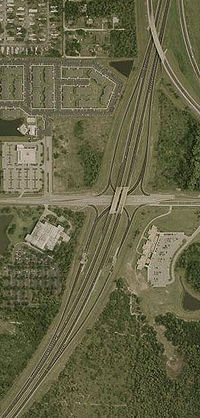
- The Single-point urban interchange, often abbreviated to SPUI, is a modification of the diamond interchange and has its ramps meet at one point, usually on the overpass/underpass of the non-highway. This requires only one set of traffic signals, increasing its efficiency and capacity when compared to a diamond.
Freeways in the Phoenix Metropolitan area are great examples of the utilization of SPUI interchanges. Some examples of SPUI are along AZ-51 from Downtown Phoenix
Phoenix, Arizona
Phoenix is the capital, and largest city, of the U.S. state of Arizona, as well as the sixth most populated city in the United States. Phoenix is home to 1,445,632 people according to the official 2010 U.S. Census Bureau data...
all the way to Loop 101, another location where SPUI is common.
Other/hybrid interchanges
Highway/non-highway hybrid interchanges consist of diamond and partial cloverleaf elements. Their construction can consist of multiple interchange designs such as loop ramps, flyovers, and roundabouts.One form of the roundabout interchange can be used to connect a highway with a non-highway. It uses a single roundabout
Roundabout
A roundabout is the name for a road junction in which traffic moves in one direction around a central island. The word dates from the early 20th century. Roundabouts are common in many countries around the world...
, rotary, or traffic circle
Traffic circle
A traffic circle or rotary is a type of circular intersection in which traffic must travel in one direction around a central island. In some countries, traffic entering the circle has the right-of-way and drivers in the circle must yield. In many other countries, traffic entering the circle must...
which spans the highway as a over/underpass. Such junctions can be improved by adding a flyover for straight-through traffic on the non-freeway, creating the Roundabout interchange.
The three-level diamond/volleyball
Volleyball
Volleyball is a team sport in which two teams of six players are separated by a net. Each team tries to score points by grounding a ball on the other team's court under organized rules.The complete rules are extensive...
interchange is three levels high, and it handles interchanging ramps via four intersections. This kind of an interchange can also be used to connect two highways together, but due to the use of intersections, its traffic is not free-flowing.
See also
- Free-flow interchangeFree-flow interchangeA free-flow interchange is an interchange in which all roads are grade-separated, and where movement from one road to another does not require the driver to stop for traffic...
- Grade separationGrade separationGrade separation is the method of aligning a junction of two or more transport axes at different heights so that they will not disrupt the traffic flow on other transit routes when they cross each other. The composition of such transport axes does not have to be uniform; it can consist of a...
- Intersection (road)Intersection (road)An intersection is a road junction where two or more roads either meet or cross at grade . An intersection may be 3-way - a T junction or fork, 4-way - a crossroads, or 5-way or more...
- Junction (traffic)Junction (traffic)A junction, when discussed in the context of transport, is a location where traffic can change between different routes, directions, or sometimes modes, of travel.-Historical significance:...
- Unused highwayUnused highwayAn unused highway is a highway or highway ramp that was partially or fully constructed, but was unused or later closed. An unused ramp can be referred to as a stub ramp, stub street, stub-out, or simply stub.-Examples:...
External links
- Kurumi.com U.S. interchanges directory
- Glossary - Part of the publication Highway Design Handbook for Older Drivers and Pedestrians by the Turner-Fairbank Highway Research Center branch of the U.S. Federal Highway AdministrationFederal Highway AdministrationThe Federal Highway Administration is a division of the United States Department of Transportation that specializes in highway transportation. The agency's major activities are grouped into two "programs," the Federal-aid Highway Program and the Federal Lands Highway Program...
- Detailed history of interchanges with diagrams

